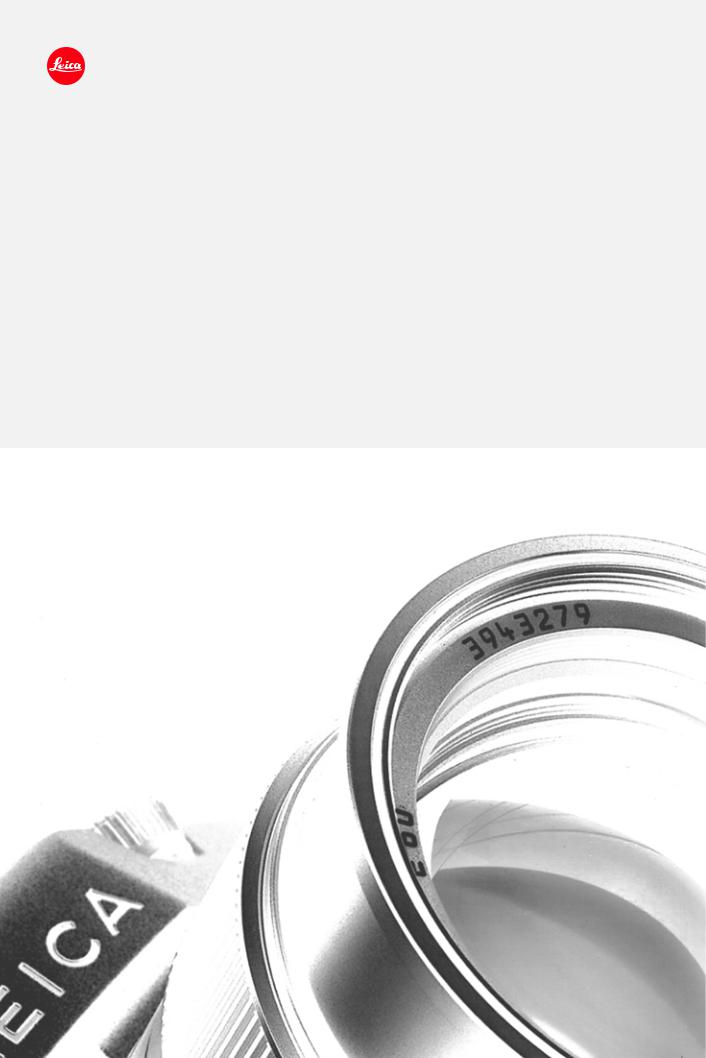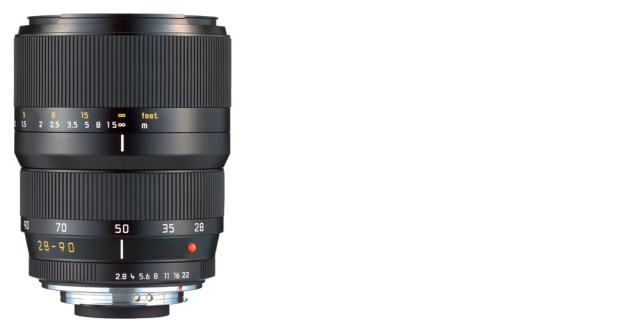Leica R-Lenses User Manual

Leica R-Lenses
by Erwin Puts
January 2004
Chapter 7: 28-90 mm lens
__ LEICA VARIO-ELMARIT-R 28-90 MM F/2.8-4.5 ASPH
|
Chapter 7 |
Leica R-Lenses |
1 |
|
|
|
|
__Introduction
The zoomlens as a species of lens design has had a strange evolution. The first design seems to be the Vario-Glaukar 1:2.8/25-80 mm for 16 mm cine cameras, created by Siemens around 1936. Especially in movies, the idea of a smoothly changing rate of magnification is very valuable as it can dispense of the stationary camera, moving on a trolley over rails. The first patent for a zoomlens is from 1902 by a USA company. The idea of a zoomlens is now more than a hundred years old. The first zoomlenses for 35 mm cameras were regarded as toys and even during the eighties of the previous century the Leica company declared that zoomlenses would never surpass the image quality of fixed focal lengths. It is Mr Kölsch who deserves the credit for two major breakthroughs in Leica lens design: the aspherical surface and the high quality zoomlens. The seminal LEICA VARIO-ELMARIT-R 35-70 MM F/2.8 ASPH and the Vario-Apo-Elmarit-R 70-180 mm F/2.8 are the proof in the pudding: zoomlenses can be as good as fixed focal lengths.
Nowadays the situation is reversed: it are the fixed focal lengths that must prove their superiority against the challenge of the zoomlens. There is no doubt: the zoomlens does not lend itself to high apertures (in the world of the digital camera this statement is not true!) and the maximum aperture is F/2.8. But with current film technology the best ISO 200 and ISO 400 slide films (and 400 ISO BW films) can compensate for the one or two stops difference between fixed focal lengths and zoomlenses.
The zoomlens has a higher number of lens elements that can all be used to correct the optical aberrations and the designer has more tools to optimize his design. We know that with fixed focal lengths there is one optimum distance (or magnification) for which the lens can be corrected. In zoomlens design the same principle holds: there is only one focal length for which the design can be optimized. The choice is obvious: one can select the medium position, the wide angle side or the tele side. For the new LEICA VARIO- ELMARIT-R 28-90 MM F/2.8-4.5 ASPH, Leica has opted for an optimization of the 50 to 90 mm range.
The designer of a zoomlens has more tools to correct the lens, but the mechanical design and engineering are more demanding. There is clearly a difference between assembling a lens with 6 elements in a stationary mount and a lens with 11 elements in a moving mount. It is already a hefty task to manufacture and assemble components with a precision within 0.01 mm consistently. The additional requirement for a zoomlens is that this same level of accuracy must be maintained with moving components. Leica does check the precision of the lens with a testcycle of 50.000
movements of the lens mount.
This new Leica zoomlens has a number of innovative features that elevates zoomlens design to a new level.
It is the first Leica zoomlens that has a zoom range above a ratio of 1:3, to be exact it is 1:3.214, very close to the magic mathematical number pi (3.14…).
The second innovation is a new and very elaborate mechanical design for the movement of the lens groups.
The third innovation is the ergonomics: the LEICA VARIO- ELMARIT-R 28-90 MM F/2.8-4.5 ASPH has one of the smoothest lensmounts I have touched, considering the fact that the lens has been made for manual focusing with a fully mechanical mechanism. The size of the lens is relatively small and fits in between the smaller Vario-Elmar-R 28-70 mm f/3.5-4.5 and the larger Vario-Elmarit-R 35-70 mm f/2.8 ASPH. That is quite good, given the additional focal length of 20 mm. The diameter of the lensmount could be held down by employing quite thin but very stable aluminium tubes. If you press very hard on the distance ring, you will increase the friction and this phenomenon has caused some users to question the mechanical stability of the new generation of zoomlenses. This is not the case, and one needs to get used to the idea that modern lenses have a different feel compared to previous generations.
The fourth area where innovations can be detected is the cosmetics: the lens has a beautiful shape and very impressive black finish.
We may add that the lens has its share of electronics with the electronic exposure compensation, useable with R8/9. No news here, but one should see it as a fifth area.
The ROM (electronic data and signal relay) contact ledge transfers information from the lens (focal length, aperture compensation and vignetting data) to the camera for correct exposure determination and flash settings (zoom reflector).

|
Chapter 7 |
Leica R-Lenses |
2 |
|
|
|
|
__ LEICA VARIO-ELMARIT-R 28-90 MM F/2.8-4.5 ASPH
__Zoomrange
The choice of focal lengths is very practical. Many years ago Canon has analysed thousands of photographs and concluded that the most often used apertures and speeds are 1:8 and 1/125 and that the most used focal lengths were within the 28 mm and 90 mm range. If we believe these studies, the new Leica lens would cover the most used range of focal lengths with one zoom movement.
This Leica lens is a fine addition to the expanding range of Vario-lenses, but it cannot be a jack of all trades.
A macro facility is not available, but can be found in the companion lens Vario-Elmar-R 35-70 mm f/4 . And for most applications, the near focus limit of 0.6 meter on the 90 mm position may suffice. The aperture range from 1:2.8 to 1:4.5 has enough speed for current high quality medium speed films. One would have hoped for a slightly wider aperture at the telephoto side of the zoomrange. But that
wish would have clashed with the desire for a compact lens. Remember that the famous Vario-Elmarit-R 35-70 mm f/2.8 had a front diameter of 88 mm and extrapolating this to the 90 mm position, one would have to live with a lens with a diameter in the neighbourhood of 120 mm and a much higher weight due to the proportionally heavier glass lenses.
The aperture ring has numbers from 2.8 to 22 and one should be aware that this range only holds for the focal lengths from 28 to35 mm.
The 50 mm aperture starts at 3.4 and the 90 mm at 4.5.
If you are at the 90 mm position, the aperture setting of 2.8 corresponds to 4,5 and the 22 is in fact 36.
One should be careful when using a handheld meter or when one uses the A-setting and wants to select a specific aperture. It is easiest to use the aperture indication in the finder.
